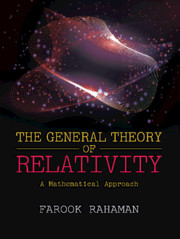Book contents
- Frontmatter
- Dedication
- Contents
- List of Figures
- List of Tables
- Preface
- Acknowledgments
- Chapter 1 Tensor Calculus — A Brief Overview
- Chapter 2 Geodesic
- Chapter 3 Einstein Field Equations
- Chapter 4 Linearized Gravity
- Chapter 5 Lie Derivatives and Killing’s Equation
- Chapter 6 Spacetimes of Spherically Symmetric Distribution of Matter and Black Holes
- Chapter 7 Particle and Photon Orbits in the Schwarzschild Spacetime
- Chapter 8 Causal Structure of Spacetime
- Chapter 9 Exact Solutions of Einstein Equations and Their Causal Structures
- Chapter 10 Rotating Black Holes
- Chapter 11 Elementary Cosmology
- Chapter 12 Elementary Astrophysics
- Appendix A Extrinsic Curvature or Second Fundamental Form
- Appendix B Lagrangian Formulation of General Relativity
- Appendix C 3+1 Decomposition
- Bibliography
- Index
Chapter 10 - Rotating Black Holes
Published online by Cambridge University Press: 24 March 2021
- Frontmatter
- Dedication
- Contents
- List of Figures
- List of Tables
- Preface
- Acknowledgments
- Chapter 1 Tensor Calculus — A Brief Overview
- Chapter 2 Geodesic
- Chapter 3 Einstein Field Equations
- Chapter 4 Linearized Gravity
- Chapter 5 Lie Derivatives and Killing’s Equation
- Chapter 6 Spacetimes of Spherically Symmetric Distribution of Matter and Black Holes
- Chapter 7 Particle and Photon Orbits in the Schwarzschild Spacetime
- Chapter 8 Causal Structure of Spacetime
- Chapter 9 Exact Solutions of Einstein Equations and Their Causal Structures
- Chapter 10 Rotating Black Holes
- Chapter 11 Elementary Cosmology
- Chapter 12 Elementary Astrophysics
- Appendix A Extrinsic Curvature or Second Fundamental Form
- Appendix B Lagrangian Formulation of General Relativity
- Appendix C 3+1 Decomposition
- Bibliography
- Index
Summary
Null Tetrad
The tetrad formalism is a transformed coordinate approach to general relativity (GR) that replaces the coordinate basis by the local basis for the tangent bundle, which is less restricted. It is constituted by a set of four linearly independent vector fields known as a tetrad or vierbein. Usually, specific tetrad basis, which is a set of four independent vector fields, is used to represent a tensor in tetrad formalism. This basis spans the four-dimensional (4D) vector tangent space at each point in spacetime. Therefore, at any point P on the curve, we can present an orthogonal frame of three unit space-like vectors
which are all orthogonal to vα (which is unit tangent vector), a time-like vector and we define
These four vectors (i = 0, 1, 2, 3) are known to form a frame or tetrad at P.
Treating as a 4×4 matrix at P, we can define its inverse (called the dual basis or dual tetrad), which follows
Actually, are four linearly independent vector fields.
We introduce a new matrix gij defined by
which is known as frame metric.
Here, are linearly independent and the global metric, is nonsingular. As a result the matrix gij is nonsingular and hence invertible, i.e., gij exists, which is contravariant frame metric. Note that
Exactly the same way as metric tensor, we can raise and lower the tensor indices with the frame metric gij.
Eq. (10.2) yields the inverse relation as
Note that tetrad vectors determine the linear differential forms
and from this the metric takes the form
For a simple physical interpretation of the frame, we can think as the four velocity of an observer whose world line is C and three space-like vectors (i = 1, 2, 3) are rectangular coordinate vectors (such as usual cartesian basis) at P. For different tetrad, one gets different frame metric.
- Type
- Chapter
- Information
- The General Theory of RelativityA Mathematical Approach, pp. 261 - 304Publisher: Cambridge University PressPrint publication year: 2021



